If you’re going on a camping trip, always equip yourself with a first-aid kit. Minor bumps and scrapes, a bee sting or just a simple old-fashioned headache can happen anywhere, so it pays to be prepared.
Most beginners tend to opt for a pre-assembled kit as a matter of convenience rather than building their own. It’s an easy way of ensuring that you have not forgotten any of the basics. Most of these types of kit are compact, water-resistant pouches that can be refilled and reused. If, however, you’re going on a longer, more demanding trip, you may need to consider additional items.
What to Include in Your Camping First Aid Kit
Before you decide to purchase or to make up your own first-aid kit, you need to carry the supplies that match your trip plans so think about the number of people participating, how long the trip is for, the difficulty of the trip and any potential dangers that you might encounter along your route, and the distance you’d need to travel if you had to seek medical assistance. However, as a general rule of thumb, every first-aid kit should include:
- An easy to follow first aid instruction manual
- Basic bandages – different sizes of bandages and tape
- Adhesive plasters of varying sizes
- Painkillers such as paracetamol or Ibuprofen, which has anti-inflammatory properties
- Medical wipes and antiseptic cream or ointment
- Calamine lotion or insect sting relief/ointment
- Indigestion tablets and any prescription medications
- Basic first-aid tools: tweezers, scissors or penknife
- Handy wipes or hand sanitising gel in case you have no access to soap and water
- Plastic gloves
- Eye pads
For longer trips, you may wish to take additional bandages, gauze pads, a sling, burn ointment, splint, forceps, instant ice pack and thermometer but you should adapt your kit to suit your specific trip.
Administering First Aid
The best first-aid kit in the world will be useless unless you know how to use the supplies within it. You should read up on basic-first aid at home first and there are also a number of specialist books on wilderness first-aid.
Anyone practising first-aid must decide what the priority of treatment is.
If you suspect an injury may have caused internal bleeding, the most important thing to do is to try to prevent shock occurring. Immediate medical attention must be sought if this happens, wherever possible. Shock occurs in all accidents to a greater or lesser extent. The shocked casualty may feel dizzy, nauseous, weak, anxious, faint, restless or giddy. Keep the casualty warm and try to keep them calm and quiet, giving them plenty of reassurance.
Read Up!
Don’t forget a first-aid kit is only as useful as the person using it, so reading a few first-aid books is a good idea and, better still; consider enrolling on a first-aid course. You never know, you could save a life.
Emergency Action
Fore advice on What To Do In An Emergency, read our article on this site.
